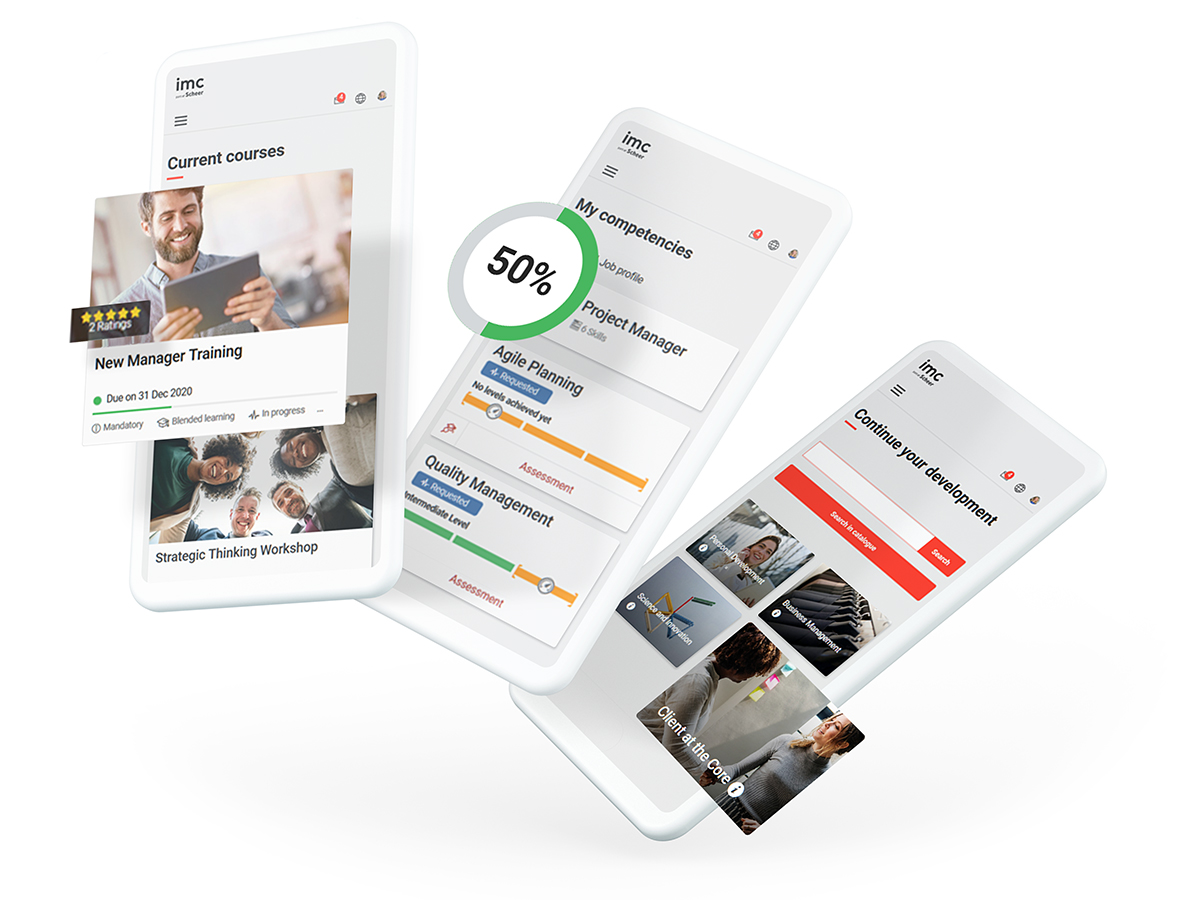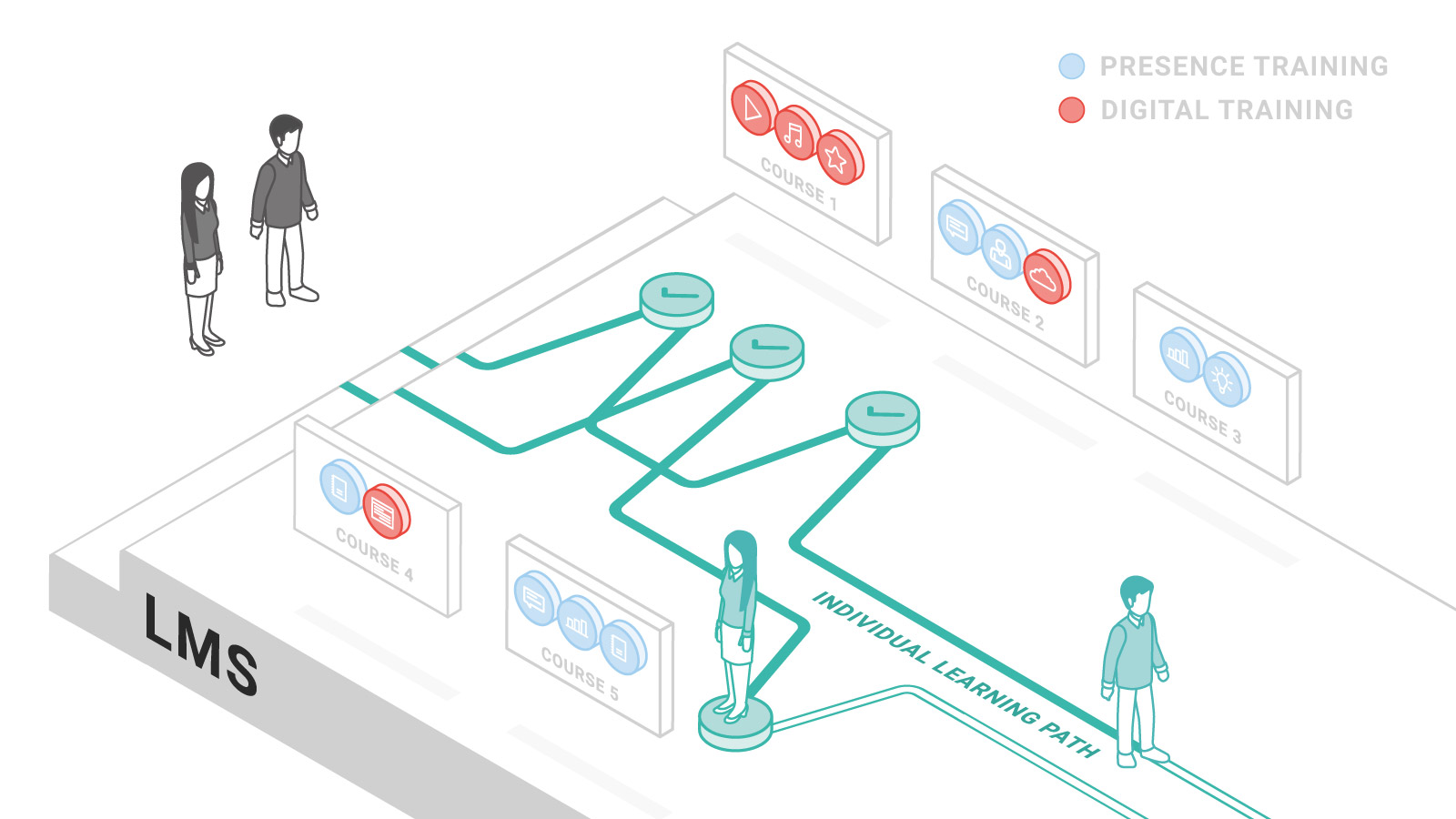
How to Implement Compliance Training Online
Here we look at how to implement compliance training online using a learning suite to automate repetitive tasks, track learner progress and ensure that refresher courses and recertifications are completed successfully.
By leveraging the latest learning technology, your organisation can stay compliant while saving valuable time and money, as well as engaging employees with the training process.
A modern ‘learning suite’ will comprise capabilities as both a learning management system (LMS) and a learning experience platform (LXP). When it comes to mandatory training to stay compliant with legal or industry regulations, the former is most relevant.
So below we look at 5 key capabilities you need in a good LMS for compliance training. We then offer 5 quick tips for making compliance training engaging, as well as effective.

Automate Compliance Training
The imc Learning Suite enables you to define target groups for training courses and book them automatically. Progress is continuously documented from the time of booking, and learners can be reminded by automatic messages to complete these courses within the required period.
An automated refresher training mechanism ensures that the course is repeated regularly, so that the employee always meets all compliance requirements. All status changes are stored throughout the entire process, ensuring that all compliance-relevant activities can be tracked and monitored across the board.
By using personal profile data, new employees can also be automatically trained according to requirements during the onboarding process. The imc Learning Suite also supports maintenance through necessary repeat training and recertification.
All compliance-relevant activities are supported by the system, from the nomination of target groups to the tracking of course progress and the so-called “chasing“, right through to the reporting of training measures.
Keep the above info block but remove ‘the’ to read just ‘Reduce susceptibility to errors’.

Assign Training
The training assignment process describes the formation of target groups for defined compliance requirements and the selection of training measures that must be carried out to meet the requirements.
The imc Learning Suite provides support by defining and selecting target groups via inclusion and exclusion rules. Assignment criteria can for example be courses, user attributes, course types, learning paths, skills, group assignments or job profiles. Target groups can be generated automatically via batch jobs that can be configured as desired or after a manual start.

Learner Tracking
The learner tracking process describes the continuous monitoring of the learning progress of training measures. So you can be sure that you meet the compliance requirements. The imc Learning Suite makes the current status of training measures traceable at any time and facilitates progress control via reports, automatic notifications, and the course progress display.
The current status of the training activities can be graphically displayed in the imc Learning Suite on a reporting dashboard. The reports can be configured individually and offer filter options so that those responsible are always informed about the status and possible need for action. On request, the reports can also be sent to the compliance officers on a regular basis or triggered by predefined events.

Chasing
For training measures that must be carried out due to legal or internal company compliance requirements, there is often a fixed timeframe for successful completion. If such deadlines are not met, this can lead to the employees not being able to perform tasks due to a lack of professional qualifications or not being entitled to perform them due to legal requirements.
To support the successful completion of such training measures, employees are not only informed about the status of their mandatory measures, but are explicitly requested to complete them within the defined period. In the compliance environment, the term “chasing“ has become established for this task. Compliance officers can not only easily create compliance training courses in the Learning Suite user interface, they can also assign validated content to users of predefined target groups.
With just a few clicks, graphically appealing and meaningful reports on compliance status can be activated. In addition to the monitoring and chasing options available via the user interface, the notification module of the imc Learning Suite can be used to define the time intervals at which the distribution groups are to be informed by email about the compliance status of employees.
Refresher Training & Recertification
The recertification workflow controls the fulfilment of compliance requirements for the respective target groups on the basis of a dynamically calculated due date. It also triggers recertification processes either manually or automatically at the optimum time.
The efficient design of the recertification process creates a high level of up-to-date information, relieves those responsible for compliance, and reduces sources of error.
!! See an error in this sentence on the original PDF!!

5 Tips for Engaging Compliance Training
Know your target group
Even though compliance today affects almost all work areas and employees, a training course should always be tailored to the target group for which it is intended. Does the target group need in-depth knowledge about compliance, or is it enough to sensitise them?
Focus on performance and outcome instead of mere information transfer
In every area of compliance there are a multitude of problems and rules. But not every possible scenario is equally relevant. Awareness of specific risk areas and possible measures are more important to the learners than knowledge of all conceivable compliance scenarios. The focus should therefore be on the cases that the target group can actually encounter or that have occurred in the past.
Focus on behaviour change
Simply learning rules by heart causes rejection by many people and rarely fulfils the goal of compliance training. After all, the learners should behave according to the compliance rules and not be able to give a lecture on these rules. The focus of a compliance training course should therefore be on changing behaviour.
Use authentic content with consequences
Examples and concrete cases where the learners can test their knowledge in an application-oriented way are preferable to knowledge queries. It is important that these examples can also be encountered by the target group in everyday work. The more concrete a case study is and the sooner it fits into the target group’s working life, the more interesting it is for the learners. This is the only way to show credible consequences that convey the relevance of the content to the learners.
The format is crucial
Compliance as an often dry perceived topic must be brought to life. Even more than with other topics, an initially boring-looking compulsory training can become a learning experience by using scenario-based approaches and storytelling, gamification elements or interactive elements to bring more life into the training. In search of suitable content? Use our popular standard content or develop content perfectly tailored to your situation together with our content experts.

The Role of Compliance in Digital Learning Transformation
Get to know more about the five benefits of how compliance training can make digital learning transformation a fundamental part of a progressive, digitally-savvy organisation.

Don’t call it compliance!
Compliance training - the term alone is a red flag for many employees. We give some tips how to create an interesting training instead.
Contact person

Birmingham 2022 Commonwealth Games case study: The challenge
Welcome to the first in our new series of posts exploring imc’s project with Birmingham 2022 Commonwealth Games. In this post, we will reveal the challenge faced by Birmingham 2022 Games, and what they needed from their new learning management system.
About the Commonwealth Games?
The Commonwealth Games bring nations together in a colourful celebration of sport, human performance and culture. Birmingham 2022 will see around 4,500 athletes from 72 nations and territories compete in 19 sports and eight para-sports. Much like the Olympics, the Commonwealth Games takes place every four years, moving cities for each event. As the biggest event ever to be held in the West Midlands, Birmingham 2022 is expected to attract more than one million spectators to the city and have a global TV audience of 1.5 billion.

The training requirement
With each event comes a mammoth training requirement. With a workforce of over 50,000 volunteers, paid employees and contractors to rapidly upskill, Birmingham 2022 needed a learning management system (LMS) to streamline the training process for their diverse team.
To find a new LMS, Birmingham 2022 went through a public procurement process to find the right vendor. Birmingham 2022 has pledged to be the most sustainable yet, so sought a solution that could be reused across a multi-games contract, by Birmingham 2022 and future committees.
For Birmingham 2022, it was vital to ensure efficiency and value for money, so it was crucial that they chose the right LMS from the very beginning. The Commonwealth Games Federation’s vision was for better knowledge transfer between organising committees, with systems and contracts carrying over from one Game to the next to reuse as much as possible.

Plans for a blended learning programme
Birmingham 2022 knew that they wanted a truly blended learning programme, comprising eLearning, digital resources and live face-to-face training sessions. The addition of the online element was relatively new, and driven in part by the challenges posed by COVID-19. This would be in contrast with the very simple LMS used by the Gold Coast 2018 Commonwealth Games, which was essentially used for ‘click next’ learning with no tracking or reporting.
The shift in focus to blended learning would enable Birmingham 2022’s training team to ensure that valuable time wasn’t taken out of face-to-face sessions to deliver soft skills training. This meant that workforce would receive their venue-specific training in person, while accessing role-specific and customer service-focused training online for more efficient learning.

Designing for a large, diverse audience
An important part of this project would be the huge learner audience, of 35,000 contractors, 14,000 volunteers and 2,000 paid employees. Additionally, this would be a very diverse audience, comprising different ages and levels of technical ability, meaning the LMS needed to be extremely accessible and user friendly.
With so many volunteers and contractors, Birmingham 2022 needed to ensure that their event scheduling platform, Rosterfy, would communicate with their LMS. This ability to transfer data from Rosterfy to the LMS would save Birmingham 2022 a lot of time that would otherwise be spent on manual data entry.
Finally, the LMS would need to support multiple different user groups over the course of the contract, along with different branding and content, so the chosen LMS needed multitenancy functionality.
Following an extensive tender process, the Birmingham 2022 Commonwealth Games selected imc as their enterprise LMS vendor of choice. The project commenced in November 2021 – nine months before the start of the games. With this in mind, it was time to get to work on creating the perfect solution in a limited timeframe.
Join us for part 2 when we will take a look at the solution imc created for the Birmingham 2022 Commonwealth Games…

A holistic learning management experience for Australia’s national rugby league
A rejuvenated approach to modernise NRL learning centre portal with a fully-integrated LMS that increased participation rates and positive learner feedback.

A podium spot with eLearning
Training is not only essential for the professional athletes, but their trainers, referees and crew members also need continuous professional development. We tell you how that works with eLearning.

What Connect Four and Software Architecture Have in Common
I’ve interviewed quite a number of imc colleagues about what exactly their job involves. I’ve put myself in the shoes of software developers, taken a peek behind the scenes in product management, and quizzed colleagues from marketing.
But I’ve never encountered anything as complex as what my colleague Eric Andre does for a living. Eric is a software architect, responsible for the imc Learning Management System (LMS). In our interview, he told me what Connect Four and his job have in common, how he trained as a software architect, and what the distinction between happiness and joy has to do with his work.

Eric Andre
Job | Software Architect
Working in | Saarbruecken, Germany
Worked at imc since | 2021
Super power | Transfering knowledge to new situations
Favourite food | Pizza

Hi Eric, thanks for making time for us today! I suspect your job description will be pretty meaningless to most laypeople. How would you describe your job to your grandparents?
Hi Nadine, the pleasure’s all mine. I would describe my job to my grandparents simply by saying that my boss gives me a whole lot of brightly coloured Lego bricks which I then put together to make something resembling a house.
Well, that actually sounds pretty simple. Can you explain it a bit further?
To understand what a software architect does, you first need to understand the function of architecture in software. Architecture refers to the fundamental way in which an entire system is organized – the basic framework. It specifies both the individual components that make up the system and the relationships, or dependencies, that exist between them.
Hence building a house is an apt metaphor. When you’re planning a house, there are certain things you must specify clearly at the outset. You can leave room for future additions, obviously, but if, for example, you want to be able to add another level at some point, you’ll need to allow for that when planning the foundations.
Software is similar in that sense. On the one hand, it must be flexible and open to change rather than static and ossified. But on the other, certain limits and properties must be maintained in the system at all times.
Connect Four is also a good metaphor. Here, architecture is like the blue grid of the game: it provides a structure within which the individual tokens are flexibly arranged and re-arranged. But it only works if the grid is designed to support this.

So, in other words, you have to plan something that doesn’t even exist yet?
Yes, that’s part of it. But I also have to make decisions very early on as to what might be important later on. That’s always a bit like gazing into a crystal ball. But with software architecture, it’s also like a house: if everything is working properly, you don’t give it a second thought. If it’s well planned, there won’t be any problems up front.
But planning doesn’t end with the initial build. It’s an ongoing process. It costs time and money, with no immediately obvious benefits. But if you don’t plan, and you just keep on building, then sooner or later things can get really expensive. There’s a great quote from Brian Foote that sums it up beautifully: “If you think good architecture is expensive, try bad architecture!”
Sounds like rather a lot of brainwork. What does your average working day look like?
I usually get up fairly early, sometime between six and seven, and go running for an hour. Then I have a coffee, preferably outside in the garden. That’s when I start thinking about my day. I have a not to-do list, and every day I jot down what I want to achieve and how I intend to go about it. In doing so, I always have our roadmap in the back of my mind.
Most mornings, work starts with our team meeting, with me generally pacing back and forth. I prefer to work standing up anyway, and I’m always moving around because I always have a lot to think through, and movement helps me order my thoughts.
In the late afternoon, I often go for an hour’s walk or do some gardening, after which I go back to my (standing) desk. My working day ends once I’ve done everything I set out to do that day. This flexibility and the freedom to switch between periods of high intensity and relaxation is very important to me.
So a large part of your work consists of planning. How do you know when a plan is finished and the architecture is ready for implementation? And what happens next?
Good software architecture demands an incredible amount of time and effort. And even then, sometimes you just have to accept that what you’ve come up with won’t work, and that you have to tear it up and start again. Only when I’ve thought everything through in the minutest detail and looked at it again and again from every angle do I know that I have given it enough thought.
That’s when the real work begins and I start defining processes and process flows, document requirements, and talk to my team, the developers and other teams. That might sound simple, but believe me, there are a lot of people and departments involved. The Executive Board, too, needs to sign off because the architecture affects the entire system.

How does one actually become a software architect?
Not through any classic apprenticeship or any one course of study. There are usually various certificates and modules involved. In most cases, including mine, you end up in this role at some point after starting out in software development. Software developers progress through various stages from junior to senior, at which point career paths branch off in various directions and you’re referred to as an individual contributor.
If you want to continue along the hands-on technical career path, you can work your way up to fellow engineer. Alternatively, if you prefer a management role, your career and further development options range from engineering manager all the way up to CTO. Or you can go into software architecture. The journey probably varies from company to company and industry to industry. But ultimately you progress from being a software developer to being an architect who must learn to delegate some of their previous responsibilities as a developer.
These days, there are various kinds of software architect, and each has a different focus. For example, there are enterprise architects, who are responsible for verifying that the organisation’s IT strategy is aligned with its mission. It’s their job to analyse both business properties and the external environment and to define all business needs.
Then there are solution architects, whose task is to evaluate all business needs and develop solutions in the form of products or services. They are the interface between business analysts and IT experts.
And finally, there are domain – or technical – architects, who mostly work as part of a team and tend to specialize in one particular technology. They can also work as technical project managers. These software architects work collaboratively to ensure the overall system has the flexibility, scalability and security required in order to meet business needs.

And what is your specialism?
I tend to see myself as a solution architect who doubles as a domain architect from time to time. The distinction is somewhat fluid, which is due to our organisational structure. My specialism is in platform architecture. I distribute systems and ensure their interoperability, and I’m passionate about service orchestration and choreography within distributed and reactive service-oriented architectures.
What key skills does your job require?
Adaptability, the ability to transfer and apply knowledge to new areas, and analytical skills. I need to be able to familiarise myself with new subject areas and problems very quickly and transfer my existing knowledge to new situations.
For instance, I’m not the best developer by any stretch of the imagination, but I know enough to be able to understand problems and quickly get a handle on the issues involved. Good communication skills are also very important, as I deal with a wide range of stakeholders.
In what respects does imc differ from other employers?
I used to work at a large US corporation, and things were done very differently there in several respects. For example, decision-making processes are much shorter there, and people are more inclined just to give something a try. Here in Germany, there’s generally a lot more discussion and planning before something gets implemented.
I’m very happy with the overall situation here at imc. The people here are very open and honest. That came across right from the outset, during my job interview and the onboarding process. But I also like the way people deal with one another. And then there are all those in-house events and knowledge-transfer opportunities.
I also really like our approach to design here – it’s all so cohesive. Plus, I like the painstaking attention to detail here, and the fact that people notice when you go the extra mile. It’s not all strait-laced and serious either – people know how to have a bit of a laugh without being puerile. I suppose it’s a little like working for a start-up, albeit one with more structure.
Also, in my role, I’m able to work with a very wide range of information and levers, and imc always gives me really good support in that regard.

Now let's go on with some random, personal questions. If you could have your time again, would you still choose to work as a software architect?
Yes, in a heartbeat. I love the challenge – it gives me great joy. And I believe that if you do something that gives you joy, then that’s the key to happiness. If something fills you with joy, you cannot help but be happy.
Please complete the following phrase: For me, digitalisation means...
...that you can’t make a bad analogue process better simply by digitalising it.
What do your colleagues value most about you?
They value my willingness to help and my openness, and also my direct manner. At least, I hope they do!
Do you have any role models, professionally or personally?
Professionally, several. At a personal, human level, the actor Keanu Reeves springs to mind. Despite his immense success, he remains grounded, uses public transport and stands up for others. I find that truly remarkable. Amid all the rapid changes of our modern world, it shows that there are still immutable principles and values that we all share, or at least should share.
Indeed! And that wraps things up nicely. Thank you for your time, Eric. Here’s wishing you continued joy in your work!

Living the dream as Hosting Engineer
Hosting is a male domain? Our interview partner Suwhathi proves this wrong! She reveals how she became a Hosting Engineer at imc and what she think about supposed male domains.

Conductors of the Software Orchestra
Conductors of the Software Orchestra: That is how Product Manager Lia from Sibiu explains her job. Find out more in the interview.
Would you like to know more about imc as an employer? Then take a look at our career section, maybe there is a suitable position for you.
We are also always happy to receive unsolicited applications!

Contact person
I have been working in the Marketing & Communication Team at imc since March 2019.
Communication, creating unique content and social media are my passion.
"One can not not communicate" - Paul Watzlawik.
To explain complex content in an understandable way and thus make the topic of e-Learning accessible to everyone is an exciting challenge every day.
Privately I love to read, play poker and travel a lot.
I am always happy to receive feedback or suggestions.

The Netflix Factor in Self-Directed Learning
How self-directed learning can be used in companies, what it adds, and where its limitations lie

Few things are exercising the minds of today’s L&D managers more than the question of how to give employees greater flexibility in their learning. This is part of a trend in many companies away from formal and towards informal learning. And from informal learning, it’s just a hop, skip and a jump to self-directed learning.
Self-directed learning, in a nutshell, is about giving employees the flexibility to decide for themselves what, when, where and how they learn. That sounds simple, but it actually requires a great deal of conceptual design work and careful technical implementation, not to mention trust in one’s employees. But it’s worth it because, planned properly and implemented strategically, self-directed learning can be a valuable complement to classic top-down learning.
This key fact is not lost on Mercedes-Benz Group AG’s Michael Temme and imc Learning's Marion Sander-Feld, who are currently working on ways of integrating new self-directed learning components and functions directly into the imc learning management system (LMS). In this article, we explain the benefits of self-directed learning, what its limitations are, and what Netflix has to do with it.
The case for self-directed learning
Given the current skills shortage, employee upskilling and professional development are matters of top priority for all companies, regardless of size. Automotive giant Mercedes-Benz Group AG is a case in point. Its approach to employee learning is guided by five key questions: what, who, where, how and when.
Mercedes is also looking closely at how face-to-face training can be translated into online learning. This requires new approaches because it is not possible to take analogue training digital without careful modifications and workarounds. Anything short of this will serve only to turn employees off.

Michael Temme, who manages innovation projects at Mercedes-Benz Global Training, is an expert on this. He has no doubt that for a training course to be effective, learners need to be able to see and understand how it is relevant to their work.
“We need to face the fact that what matters is not how much an employee learns, but how much they retain”, he says. “We know that learning content is more memorable if learners are able to apply their learnings immediately and are free to select the learning method that works best for them. People have to be able to decide for themselves what, when and how they learn. That’s why we use self-directed learning methods.”
No obvious benefit = no lasting learning
According to Temme, one of the major challenges with self-directed learning is that it requires both different skills and different (digital) systems from those required in conventional learning. For example, when trainers are in the same room as all the course participants, they can ask whether everyone has understood the material and, if necessary, can provide additional details or explanations.
This learning-reinforcing element is a lot more difficult to create in digital settings. To make up for this, Mercedes is employing a number of approaches, including the use of sharing and learning-specific networking (social collaboration) in the LMS.
Self-directed learning also requires employers to place a great deal of trust in their employees, in return for which the employees need to be extremely self-organized and highly self-motivated. The point is that employees will only feel motivated to learn in the first place if they can see that what they are learning is relevant and will benefit them in their day-to-day work.
Just as importantly, they will only retain what they have learned if they are able to apply and reinforce it in their day-to-day work very soon afterwards, as Ebbinghaus’s Forgetting Curve shows.
The Forgetting Curve produced by German psychologist Hermann Ebbinghaus shows that after 20 minutes, you will recall only 60% of a text you have learned. The loss of retention continues over time, so that after 60 minutes, you will recall only 45% of what you learned, and after 24 hours only about 34%. Long-term, you will retain only about 15% of the text you learned.
Paradox: More courses, poorer learning outcomes
Temme also notes that the vast amounts of digital learning content generated during the pandemic resulted in many learners feeling overwhelmed by the sheer volume of courses and unable to tell which ones were actually relevant for them. In other words, offering more courses does not necessarily lead to greater initial learning or long-term retention.
For this reason, Temme increasingly favours problem-based learning over classic ‘ready-made’ learning content. Learners engaging with a real-life problem or question can, by using the right social collaboration tools, for example, quickly and easily work their way towards a real-life solution with support from other learners and/or from experts.
By using social collaboration in this way and by learning in the moment of need, learners retain their learning for much longer. They progress from inert knowledge to understanding and, by applying that understanding immediately, they achieve specific competencies.
Netflix-style learning with channels
This leads into an important new feature that imc AG is currently developing for its LMS, the imc Learning Suite, in partnership with Mercedes: channels. The idea of channels is to make learning as easy as watching Netflix or YouTube: learners simply select topics they find interesting or that are relevant to their needs and are then presented with matching content recommendations.
It doesn’t matter what a topic’s form or scope is. The learner is shown everything that matches the topic: everything from short learning nuggets to in-depth explanatory videos to learner-made tutorials. The main focus, however, is on learning nuggets that are readily consumed as part of independent research and can be created without too much investment of time and effort on the part of experts.
These short learning units offer the added benefit that they can be quickly consumed in the moment of need and on the job, which leads to improved internalisation and retention of knowledge. Consequently, the learning outcomes are superior to those achieved in situations where employees first learn and then try to recall the knowledge months later when they need to put it into practice.

Users receive notifications whenever new content is added to the topics to which they have subscribed. Marion Sander-Feld, Head of Product Management for imc Learning Suite, explains: “Channels are topic-based containers. They are represented on screen by tiles and can contain various didactic learning nuggets, such as videos, links or PDFs. The scope is not limited to highly professional and expensive-to-produce training courses.
This is intentional, because we also want the channels to provide content that can be produced quickly in order to meet urgent learning needs. In providing this new feature, we also want to enhance the learning experience because making it faster and more intuitive to navigate the LMS and find the desired content significantly improves learning outcomes.”
By expanding the learning offering beyond the usual highly polished web-based training sessions and enabling all users to post their own learning content, channels will make learning a more bottom-up and accessible experience for all. This addition of user-generated content, which all subject experts will be able to create with ease, will help to reduce knowledge loss.
Limitations of self-directed learning
So far, so good. But as is so often the case, self-directed learning is not necessarily the one and only solution that’s needed. There will always be content that employees are loath to engage with – courses on data protection, compliance or IT security, for example.
These are extremely important topics that require not just learning, but genuine internalisation, so it’s best not to leave that entirely to voluntary self-selection. But even with compulsory training like this, the managers responsible should still apply the problem-based strategies of self-directed learning.
Thus, if the topic is cyber security, the content should present concrete examples and real-life problem scenarios that show employees how they can help prevent cyberattacks. And if this approach works with less-than-popular courses, it is sure to be a major success when it comes to self-selected content. Because learning should be like watching Netflix: child’s play.

Diary of an LMS
If an LMS wrote a diary - what would it say?
We thought about that and share some tips for LMS professionals, told a little differently...

Informal learning: Everyday hero of work
“Formal learning is like riding a bus. Informal learning is more like cycling.” We explain what this means and share some key facts and recomemndations

More about our LMS
If you would like to learn more about imc's Learning Management, check here for more information.

Contact person
I have been working in the Marketing & Communication Team at imc since March 2019.
Communication, creative content and social media are my passion. "KISS - Keep it short and simple" is my credo.
To explain complex content in an understandable way and thus make the topic of e-Learning accessible to everyone is an exciting challenge every day.
Privately I love to read, play poker and travel a lot.
I am always happy to receive feedback or suggestions.

The Role of Compliance in Digital Learning Transformation
Here we look at the important role of Compliance within digital learning transformation projects. Whether you have an Audit / Compliance or L&D role, digital transformation is likely impacting your plans, especially if you work for a large, forward-thinking organisation.
According to Gartner, global IT spend will hit $4.4 Trillion in 2022. Despite geopolitical uncertainty and residual pressures from the pandemic, business and IT leaders are actually looking to invest more in digital technology, in order to ensure greater flexibility and future-proofing of their organisations.
In fact, “Investment in direct digital transformation projects is projected to grow at a compounded annual rate of 16.5 per cent from 2022 to 2024” according to the International Data Corporation.
When it comes to digital transformation programmes, leadership teams are often sold on the ideas of faster processes, cost-savings and slicker sales enablement. For L&D, the Covid-19 pandemic accelerated the trend towards digital learning, as the face to face classroom environment became impractical.
What tends to get neglected within digital transformation is the area of Compliance. Legal and regulatory compliance is often seen as a tick-box exercise - “make sure passwords are secure for that new software”, “make sure the new guy gets his health and safety walkthrough before he starts” etc.
However, digital transformation can deliver as much in the way of improvements and efficiencies for Compliance teams as for any other department, while embedding compliance considerations can streamline every department’s processes by automating many recurring tasks related to training.
If you are involved in a digital learning transformation project, here we look at some of the key compliance considerations and potential benefits.

Automated alerts to new laws and regulations
A key role of Compliance teams is to keep track of the latest applicable laws and industry regulations, then liaising with L&D and / or relevant departments in order to roll out training accordingly.
When a robust, well-integrated learning platform is in place and you have an easy to use elearning authoring tool, the Compliance department may be able to update or add relevant information to the platform themselves so that push notifications will get sent to the appropriate employees automatically and if necessary, instantly.
Alternatively, Learning and Development teams can integrate the new information into the next round of training made accessible in the right place, at the right time.
Hassle-free audits
You may be quick and diligent when it comes to delivery of compliance training, but when it comes to an audit from external bodies, this needs to be proven.
Digital learning transformation reduces or completely removes the need for certification paperwork, so that demonstrating the appropriate level of training and accreditation becomes much quicker and easier. Gone are the days of lost certificates - hiding in the wrong file.
A good learning management system (LMS), such as the imc Learning Suite, makes all training and certification information easily navigable and searchable.
Personalised learning and refresher training
Often, compliance training is required when an employee joins a company or starts a new role. This means that revised or refresher training is required on a very individualised schedule.
Digital learning solutions enable these requirements to be managed for each employee as they progress through an organisation or take on new sideways responsibilities.

Powerful data
Compliance teams are often under pressure to do their jobs while staying out of the way as much as possible in order to allow employees to get on with their day to day responsibilities, such as customer service, operational work or revenue generation.
A digital learning platform gives L&D and compliance teams access to useful data so that trends can be seen in where an individual might need additional support for certain aspects of training or where a certain course is causing strange delays or roadblocks.
Such data can enable personalised learner interventions rather than bombarding a whole department with additional training that only a few people need to stay compliant. It also allows Compliance or L&D teams to improve training content that causes bottlenecks for a whole cohort of learners.
Risk mitigation
The whole point of the Compliance function is to allow an organisation to run fluently while staying on the right side of the law or industry regulator.
Through access to data generated by digital learning systems, a Compliance manager is empowered to better manage risk across the company. An effective digital transformation programme integrates every department and a great deal of their training.
Without acting like a ‘Big Brother’ presence in the company, the Compliance team can look into the development of processes and related training, offering guidance and risk mitigation processes along the way.
In Summary
The five principles above offer a guide to how Compliance teams and their collaboration with L&D can make digital learning transformation a fundamental part of a progressive, digitally-savvy organisation.
For those companies on a broad digital transformation programme, Learning and Compliance can help every department to run ever more smoothly and efficiently while managing the risks that come with any change much more effectively.

Don't call it compliance
Most of the time, employees are reluctant to complete mandatory compliance training since it's always unengaged and dull. We give some tips of creating an interesting training instead.

Efficiently implement compliance topics
Discover how to improve employees motivation and learning experience by using a modern learning management system platform.

Diary of a Learning Management System
imc Learning Suite: Six pro tips to make your life easier when working with the LMS
Ever had words with your car? Yelled at the TV? Sworn out loud as you stab angrily at your PC keyboard? Or muttered “stupid system!” – only to discover, somewhat sheepishly, that the problem lay with you, not the system? It’s OK, we’re no different. Our consultants are intimately familiar with this phenomenon, too.
That’s why we talked to our consultants about the misconceptions and obstacles that most frequently cause LMS clients grief, and how they can be overcome. And sometimes it’s good to see things through the other person’s eyes, so we’ve decided to write this from the point of view of our learning management system and share some tips for a better handling of the LMS. That’s right, you may not be aware of it, but our LMS has feelings too, and it’s only trying to help!
The following excerpt from the diary of our learning plattforn is a light-hearted take on human-system interaction, but it contains genuine and practicable expert advice that will hopefully make working life less stressful and more relaxed for all concerned – you, the system, and our consultants.

Dear Diary,
8 a.m.: Dealing with a sudden mass influx of visitors
This morning, I wasn’t even fully awake and was hoping for a slow start to my day, but then I received another error message from China. It was from that important guest who checked in recently. Humans, by the way, always call guests “clients”, but “guests” sounds so much nicer to me.
Anyway, this super-important guest thinks it’s okay to check in an additional 50,000 learners without first telling us and giving my human colleagues – imc’s consultants and architecture experts – a chance to make the necessary server preparations. These preparations are quick to implement, but they’re not instantaneous. I mean, have you ever tried to find room for 50,000 guests who show up on your doorstep unannounced? We pride ourselves on being great hosts, and part of being a great host is being prepared.
Pro tip 1:
If you know you are going to need a large volume of additional licences, please give the consultants in charge seven to ten days’ advance notice.
Note: This does not apply to completely new clients or enterprise groups. In these cases, the preparations take an average of three months, as the process is a lot more involved.
12:15 p.m.: Bugs vs. user errors: Banishing misconceptions
My personal coach, Lia, always says I need to work on my stress management – it was her recommendation to keep a diary. I like Lia. She listens and helps me manage my endearing little peculiarities – the things that humans for some reason call bugs.
Bugs! Such an unkind word to use, given that everyone has their little quirks and tics. And to be perfectly honest, many of so-called bugs are not actually my fault, they’re user errors. There is always potential for user error, which is why my human colleagues and experts – wonderful people like Andreas and Christian – are there to help. They are excellent human-machine interpreters and are only too happy to clear up these sorts of little misunderstandings and misconceptions.
Pro tip2, for system administrators
Please do the user training sessions with our consultants and refer to the relevant training documentation. It will save a lot of time, boost productivity and reduce stress. That’s a promise!
1:00 p.m.: How gamification boosts motivation and enhances learning outcomes
It’s so pleasing to see that my new functions are being accepted and used by more and more guests. And to think that only a couple of years ago, they still had to log in separately to every system I’m connected to. Such a chore and a bore! But now, thanks to single sign-on authentication, it’s all so much simpler, and they can now access the entire learning ecosystem with a single click.
A lot has happened on the gamification front too. Being able to collect badges after completing courses is extremely motivating and makes learning much more fun. Up until quite recently, gamification tended to be frowned upon, especially in the more staid German companies. They’re supposed to be learning, not playing! Well, I disagree, because I can combine learning and play.
Successful learning comes from motivation, which is why I wholeheartedly recommend my skill management feature. With skill management, I can facilitate employee development by highlighting the skills employees already possess, and those they are yet to acquire.
The employer can then compare this information with the skill requirements in job profiles to identify which candidates still need development in specific areas, and which ones are suitable for the role because they already have the required skill set. This can be applied to all selection scenarios, from promotions to filling vacancies. I firmly believe that not using this feature is a wasted opportunity, particularly for guests who have a lot of office-based employees.
Pro tip 3
Don’t be afraid to move with the times! E-learning is so yesterday. Today, it’s all about creating unique learning experiences. Whether it’s small hacks, the use of gamification, or skill management, your employees will not only love it, they will become more productive.

3:30 p.m.: Using Netflix-like features to create unique learning experiences
Time for a coffee break, time to share a little secret: I will soon be getting some amazing new functions. And the best thing about it is that people are comparing me with Netflix – finally, a function that’s instantly recognizable for every user! Very clever of my developers to have come up with this: my new ability to recognize when different items of learning content deal with related topics. I can now recommend new courses or learning videos based on these similarities.
I can’t wait to see how this function is received once the first guests start trying it out. Who ever said learning systems are unsexy?
Pro tip 4
You should definitely check out the new channel function. Channels not only look great, they transform learning into a real experience.
3:45 p.m.: Courses and learning paths made easy
That’s my caffeine fix sorted. Time to move on to the next real challenge – in the form of a new guest from Australia. This guest creates three new courses, then complains that there’s no easy overview of who has done the courses or completed the tests.
But that’s another major misconception, unfortunately, because the solution he needs is already there: learning paths. Let me explain. First of all, there’s learning content. That can be any kind of training, whether face-to-face or digital. If I combine multiple items of content, then that’s a course. I can then combine multiple courses to create a learning path. If I want to, I can then also define various course prerequisites.
The idea of prerequisites is that the learner can’t progress to a higher-level course until they have passed the courses below it. You can even create placeholders – course templates – for individual courses in the learning path if, say, the course dates have not yet been finalized. Guests can then book the relevant courses in the learning path once the dates have been finalized, and the courses created. With this set-up, the administrator will always have total transparency regarding how far along the learning path the individual learners are, and can see full details of the courses.

Pro tip 5
Learning paths need to be well thought out because they are intended for longer-term development programmes. In that sense, they are like semester schedules at universities. The latter comprise various lectures or courses, and by the end of the semester, students need to have attended all the lectures in order to pass.
So, it’s important to think carefully in advance about the purpose for which an item of learning content, a course or learning path is being created. Once you have created a learning path, it’s not that easy to make changes. If you are unsure, it’s best to double check with our consultants.
5:00 p.m.: Smart decisions with learning analytics
What a day! But the end is in sight. Meanwhile, there’s something I really want to get off my chest: I’m a precision system, and I can show humans exactly what they want to – or are allowed to – see, but only if they correctly specify what they want via my user interface.
The same principle also applies to authorisations. It makes total sense that sales consultants who only sell, say, drilling machines should not need access to user guides for gardening tools. But to give effect to that, you actually need to specify it in the roles and rights concept. That way, the group defined as “sales consultants for drilling machines” will only be able to view user manuals for drilling machines.
Also, my creators are constantly talking about learning analytics and how it can be used to create really cool dashboards. That’s another new functionality that I’m very proud of. Learning analytics enables you to “measure the business outcome of the learning process,” as my big boss and Head of Product Management here at imc, Wolfram Jost, would say. In other words, learning analytics lets humans track whether they are getting a good return on their investment in learning. Definitely a key technology to keep an eye on!
Pro tip 6
To get the right answers, you have to ask the right questions, so, if you would like to make purposeful use of learning analytics, it’s worth talking to a data expert or asking our consultants about targeted training courses.
6:00 p.m.: Performance review and new developments on the horizon
Well, it’s nearly time to finish up for the day, and I’ve got a really nice evening planned. The product management team will be coming by shortly, and I’ll be paying really close attention to what they say, because it’s about my future. I love my product managers because they’re always checking me over closely to spot untapped potential and find ways of making me even better than my competitors. Time to grab some data snacks, sit back and relax. I can’t wait to find out what updates they’ve got in mind for me.
Ok, Diary, talk to you again tomorrow!

Learning Ecosytem: A universe of Learning
If you want to use a learning ecosystem successfully in corporate learning, the technical requirements must be right. Time to shed light on what systems have to fulfil in order to be able to meaningfully map a genuine learning ecosystem.

The Ultimate eLearning Jargon Glossary
LMS, LXP, SCORM, WBT, EPSS, NGLE, CBT, ITS!? Lost in a world of elearning terms and abbreviations? No worries, we can help. In this A to Z, we shed some light on the subject and have compiled a list of the most important terms and abbreviations in the field of e-learning in 2022.

More about our LMS
If you would like to learn more about imc's Learning Management, check here for more information.

Contact person
I have been working in the Marketing & Communication Team at imc since March 2019.
Communication, creative content and social media are my passion. "KISS - Keep it short and simple" is my credo.
To explain complex content in an understandable way and thus make the topic of e-Learning accessible to everyone is an exciting challenge every day.
Privately I love to read, play poker and travel a lot.
I am always happy to receive feedback or suggestions.

Delivering Measured eLearning Results
Here we look at how to plan successful eLearning that will transform results across your organisation - and it all starts with defining your training needs in the context of wider business goals.
Get the planning stage nailed, with buy-in from all your stakeholders (including your learners), and the rest can fall into place and feel like a breeze.
The problem with many eLearning projects though - as with many technology projects - is that so many people leap straight into choosing the solutions before they’ve really identified and agreed on their current and future training requirements.
So here we’ll offer a step by step guide to successful eLearning for L&D managers so that your colleagues and learners will love you.

eLearning is Now an Expectation
eLearning is now a common way for organisations to deliver training and your employees are likely to have used it in some capacity - even if it’s just during their education or a company onboarding process.
It has now evolved into a standard way of making training content available any time and anywhere, enabled by ubiquitous internet access by mobile or WiFi, and by websites or learning platforms making it accessible on phones and tablets, as well as a desktop computer.
During and post-pandemic, eLearning will be the only way for training to happen at all for many organisations.
So as there are now fewer barriers to delivering eLearning and it has become so important, here are key steps for making it effective:
1. Needs Analysis and Consultation
Arguably, this is the most important part of an eLearning project, because if done well, it gets everyone on board to help you and gives you the reasoning and structure for every subsequent stage.
- Why this project? What are you looking to achieve? If you have eLearning in place already, what improvements are you looking for, and if you don’t - what do you want this project to bring?
- Is eLearning suitable? Usually, the answer is yes - as knowledge-based content allows learners to consume it at the time, place and pace that suits them. However, for some manual / skills-based roles, it may not be the case, so could traditional, face to face training or a mix - blended learning - be the best choice?
- Cost-benefit analysis - what might this project cost and what are the expected business benefits in terms of cost-saving, efficiency or revenue generation?
- What do your learners want and need? Listen to their views on knowledge and skills gaps, and where there is an agreement, look at a bottom-up approach to complement top-down from L&D and HR management. If learners feel that they have contributed to the process, they are much more likely to engage when the eLearning is ready.
2. Resourcing the Project
However small your L&D team, delivering an elearning project should always be a collaborative project and involve multiple professionals.
The same person may perform more than one, but rarely all of the roles below, so the L&D manager will need to resource at least the following:
Project Manager
Who will lay out the milestones and timescales and work to keep everything and everyone on track?
Subject Matter Expert (SME)
Depending on the nature of the training, the person or people who understand the subject and can lay out the curriculum and materials.
Instructional Designer
The person who can translate the content into the storyboards and course progression to help people learn in the most effective manner, with an understanding of what works in an electronic format.
eLearning Developer
The technician with the skills to turn the plan into the reality of an eLearning course, including text and images, audio, videos or any other media, along with the ability to track, measure and collate data on learner progress.
Unless you work within a very large L&D team, you’ll need to look outside your organisation and outsource some or all of the above roles. A specialist eLearning company will tend to have skilled professionals with experience in working well with clients or taking responsibility for the entire project efficiently.
So how do you choose the best eLearning company for your needs if you go down that route? Many will have slick sales professionals and showcase multiple awards, but what matters most is experience working with companies like yours.
If you are part of a large, global organisation, does the eLearning provider have experience at that scale and of multinational, even multilingual projects?
Do they have experience in your sector?
These details are much more important than a sales presentation!
3. Design & Development
Again, planning this stage in advance is key. Does your project need to run within a specific timescale or a particularly tight budget? Both these factors will affect the nature of the eLearning that is feasible.
What mode of delivery is most suitable for the nature of your training and your group of learners? Text and images might work well for purely informational content and knowledge retention, whereas training the ability to adapt to on-the-job situations like customer service may lend itself to scenario-based training and something more interactive.
Close collaboration between the subject matter expert and the instructional designer will allow for the content to be delivered in the best possible way while adhering to any technical constraints.
The instructional designer then needs to work closely with the eLearning developer to bring the content to life, ensuring that it works well on any device that may be used and that it is accessible for any type of current or future learner.
4. Quality Assurance
An important point here is that quality assurance (QA) is not a task to be done only by the developer as a final step. Good QA is done independently by someone external to the design and build process, as those people may have become too close to see all the potential real-life issues.
Ideally, the project managers, SMEs, and end-user managers and even selected learners will all have the opportunity to offer feedback on eLearning before it is signed off and rolled out.
5. Roll Out & Implementation
Most technology-related projects that fail do so not because of an issue with the product, but with the communication and implementation process.
New systems often turn up as yet another piece of work - something else to think about and squeeze in around the existing workload.
If there was adequate consultation at all levels during stage 1, the implementation of eLearning should arrive not as a surprise and even as a welcome addition, because the benefits to learners and managers will have been communicated and expected.
Rather than having to convince employees to engage with your new eLearning, the focus can be on guiding learners and managers in how to make it work well for them.
6. Measurement & Evaluation
How will you measure the benefits of your eLearning project?
What metrics will the L&D team measure to judge effectiveness?
What metrics do other stakeholders care about?
Along with your own learning outcomes, taking the targets of other departments into account will help to make this a more collaborative and successful eLearning project.
Don’t neglect subjective feedback alongside the quantitative results in terms of learning outcomes and business impact. How much your learners enjoy and engage with the training is an important factor when looking at how well it will work for future learning needs, and what you might want to change or tweak.
All eLearning projects are unique, but by following each of the six key steps above, you can help to minimise the common risks and maximise the benefits and overall success.

How much does an LMS cost?
How much does a Learning Management System cost? And which will appear after the implementation? We share some insights and explain, what these questions have in common with buying a house.

"The users decide whether or not a learning offer is successful'
"The goal of a learning platform must be to help people do the tasks in their job better," says Uwe Hofschröer from Learning Strategy Consulting at imc. In the Job Slot, he explains what he means by that.
Contact person

Increase Customers Live Time Value and Earn Their Loyalty
Here we look at how to improve customer service, retention, satisfaction and live time value with Customer Education.
Business leaders know that, on average, it is 5X more expensive to acquire new customers than it is to retain existing ones. Furthermore, it is usually far more profitable to upsell and cross-sell to existing customers than it is to simply increase your number of customers.
Customer education can be a powerful tool in helping you to build trust, retain existing customers and ultimately, increase customer lifetime value (LTV).

What is Customer Education?
Customer Education is learning content designed to engage new or existing customers and help them to maximise the effectiveness of your products and services.
When it's done well, it can help to reduce customer service calls and in turn, reduce costs. It can help you to retain existing customers, and even turn some of them into enthusiastic advocates of your brand.
Customer education, also known as customer training, is so important that, according to a Salesforce survey in October 2020:
“80% of customers say the experience a company provides is as important as its product or services.”
Customer education tends to be most relevant for product-based companies, whether that’s physical products or software. It can be of most benefit if your product:
- has a learning curve, where it’s common for customers to make mistakes or get stuck
- requires people to change existing behaviours
- generates frequent customer support calls
- is used by people with a wide range of needs or in diverse contexts
- is updated regularly with new features (very common in software)
- lends itself to cross-selling or upselling (customer education can be a great sales tool!).
While customer education can be delivered face to face, online training enables any time, anywhere learning that is accessible at the user’s convenience. The Covid-19 pandemic greatly accelerated the trend towards online, helping many companies to deliver up to date content even when face to face was not possible.
Online customer education provides greater opportunity to deliver training across multiple formats, including any of:
Video guides
Hosted on platforms like YouTube or Vimeo, or on your own learning management system (LMS).
Live or recorded webinars
Guide new, existing or potential customers through your product usage. When live, you can respond to any questions on the fly, and for those who want to watch it later, the recorded version can act as a useful, video-based FAQ resource.
Infographics
An engaging, fun way to present facts and figures in a creative manner.
Slideshows
A common way to quickly convert traditional, face to face presentations into an always-accessible digital format.
Games and quizzes
An excellent way for customers to test new knowledge and see if they need to return to materials or seek additional support.
Customer Education Benefits
This can greatly reduce the cost associated with large support teams and the frustration customers feel when waiting in queues.
Customers get up and running with your product quickly because they have learning materials to hand if, as and when they need it most.
A huge issue in the field of IT and software products, which inevitably come with some learning curve. Most IT implementation projects fail, not because of a weakness in the product itself, but due to inadequate customer training and in turn, user adoption.
The point at which customers are engaging with your product is often the best opportunity to highlight your related products and services. If you can win their trust in and enthusiasm for Product A and make the customer confident that they can use it, that’s a great time to draw their attention to Product B, C, D….
This is frequently the greatest benefit to a good customer education programme. A customer who is happy with your solutions because you helped them to maximise the value of it, is much more likely to renew or upgrade when the time comes.
So clearly, there are numerous benefits to making training available to your customers, but how to make this easy and cost-effective? That’s where a customer education platform can make things efficient and highly scalable.
Customer Education Platform Features
The best customer education platforms will help you to not only upload training materials to make them accessible online, but will offer a range of useful features and attributes that include:
- Integrations with popular software products like eCommerce payment gateways (such as PayPal) or CRMs (such as Salesforce) to reduce admin, while ensuring data security.
- Scalability: You’ll want your platform to handle a growing customer base, and not become a limiting factor.
- Multilingual capabilities - if you run an international company, you’ll want to make eLearning content available to customers in multiple languages
- User analytics: Data and reports will help you to learn what content and formats are engaging your customers and where people seem to struggle or switch off. This can help you identify weaknesses in your learning materials - or even the product itself. It can also help you to intelligently signpost customers to areas of your platform for additional support.
Well-designed training materials that are kept up to date and made available via a good customer education platform should be seen as an investment in customer success, retention and new business development, rather than just a cost.
Guiding users in making the most of your products should deliver increases in customer lifetime value / LTV, win you new fans, and strengthen the reputation of your brand.
Happy to help
For 25 years, imc Learning has created eLearning solutions for customer education and staff training at companies and public sector organisations across the globe.
Our clients include the likes of Deloitte, Vodafone, BASF and Audi.
If you’d like an informal chat about how we could help you leverage customer education to improve customer service and retention, get in touch with us here at imc Learning.

LMS for Membership Organisations
Make an effective LMS platform for your membership organisation with key features such as eCommerce, adaptive learning and analytics.

Learning Ecosystem: A Universe of Learning
Create a learning ecosystem in the LMS that promoted self-directed learning in the long term.
Contact person

How to Increase Channel Sales Revenue with Extended Enterprise Learning
Here we look at how to increase channel sales revenue with extended enterprise learning, whether that’s via franchisees, resellers / affiliates, distributors or even your existing customers.
If your company has a sales team, it’s common to focus your efforts as a manager on equipping your employees with the strategy, knowledge/skills and assets they need to maximise new business. However, few companies operate in isolation and there is often an extensive network of partners that could work better to help you sell more of your products or services.
That network potential is known as the Extended Enterprise....

What is Extended Enterprise?
Extended Enterprise is a term coined by Chrysler in the 1990s to describe the collaboration between a company and its supply chain to gain competitive advantage. Since then, it has broadened to encompass a company’s entire network of collaborative relationships from suppliers to logistics, retail partners and end-users or customers.
Paying attention to the entire extended enterprise (sometimes referred to as the ‘Value Chain’) allows managers to see opportunities to improve efficiency, elevate sales and maximise profits.
The concept can be applied to any 3rd parties who can directly influence the success of a business. So, by fostering more collaboration at all levels outside your own company, potential partners can be leveraged beyond them just performing their main role (i.e. doing the bare minimum).
Ways to Increase Channel Sales Performance
Here are 5 ways to increase channel sales performance that can be adopted by any marketing or business development manager with a network of partners:
1. Measure performance frequently, and from the outset
Before diving straight into a new programme of activities to boost revenue, it’s important to measure existing performance so that you can see what partners and tactics are seeing progress over time.
Establish your current baseline, then track changes consistently so that you can see patterns across activity and new business generated.
Sharing performance data with your channel partners will build trust as it will show you are invested in their performance, and will help both you and them to see what is working.
2. Incentivise channel partners
Your internal sales team is likely compensated based on business development performance. However, suppliers and logistics providers may be doing business with potential new customers. Give them a strong reason to think of recommending you - don’t limit revenue incentives to traditional sales channels, such as retailers.
3. Provide assets that communicate your brand and sales messages
Sales teams are always provided with marketing materials that communicate the latest messaging to reinforce your unique selling points and branding. However, external partners are not always given the same benefits.
By viewing every member of the extended enterprise as part of your team and as a potential salesperson, you’ll naturally think to give them all the latest materials and insights.
In the world of web hosting for example, affiliate schemes are extremely common. Website hosts often provide affiliates with a login area containing a knowledge hub of sales advice and a wide range of adverts for use on an affiliate’s own website.
4. Create bite-size learning content
If it’s your own sales team, it’s their job to study and absorb your new, 50-page product brochure. If it’s your logistics provider - they’ve got their day job to focus on and an in-depth manual will be too daunting.
Be selective and give them some bite-size learning materials that will allow them to further their knowledge of your products and services to the level where they can be a good advocate for your company.
5. Communicate proactively
Don’t just hand over new learning materials and expect the new business to start rolling in. Check-in regularly with all aspects of your extended enterprise and make sales performance a key part of the discussion. Not only will it show partners that you are serious about their sales potential, but you’ll learn about what aspects of your extended enterprise learning content is working for them. Maybe affiliates love it, but suppliers find it cumbersome. Listen, learn, tweak and repeat.
So, if you think following the 5 principles above might work for your company and your existing or potential channel sales partners, how do you make communicating and sharing knowledge and assets with them easy? That’s where an extended enterprise learning platform comes in.
Extended Enterprise Learning Platforms
The extended enterprise learning platform creates an environment for sharing knowledge and best practice, and making the latest materials available for your channel sales network wherever and whenever they need it.
Also known as an Extended Enterprise LMS (learning management system), this platform should make it easy to add or update partner training materials with little to no duplication of effort across different internal or external user groups.
Here are some of the key features of the best extended enterprise learning platforms:
Whoever creates and distributes your knowledge and sales materials for your internal and external audiences should be able to do so via a single user area.
A multi-tenancy LMS enables you to create different user experiences for different types of external partner, such as suppliers, franchisees or distributors without being distracted by irrelevant training pathways or materials. You can even create a unique ‘tenant’ area that is set up with your partner’s branding (or co-branding with theirs and yours) to make them feel at home.
Rather than handing over some learning materials and leaving partners to get on with it, you can really increase channel sales revenue by offering ongoing support and, if appropriate, allowing a level of interaction across user types. This can lead to knowledge-sharing that breeds new ideas, collaboration and synergies.
You don’t want an extended enterprise learning platform to be yet another piece of software to get to grips with and that adds another layer of logins and admin duplication. A good extended enterprise learning platform will integrate seamlessly with your existing IT systems.
While ensuring data security, system integration will allow user data sharing with HR system for internal staff and your CRM for channel sales partners for example. Single sign-on (SSO) eliminates the hassle of logging in and out of various systems with various passwords.
If you’re rolling out an extended enterprise learning platform to help boost channel sales revenue, you’ll want data on how it’s affecting performance across each part of your partner network. A good platform will give you reporting and analytics tools that give you actionable insights across geographies and partner types.
Find which content is not getting looked at to understand what is not engaging partners. See which partners are driving the most new business and align that with their use of learning and sales materials to then use them as the benchmark for best practice.
This information will help you to turn extended enterprise learning into a machine for driving new business via channel sales - whether that’s from existing partners and distributors or leveraging the potential of your supply chain.
Whoever creates and distributes your knowledge and sales materials for your internal and external audiences should be able to do so via a single user area.
Can we help you to increase channel sales revenue with an extended enterprise learning platform?
Get in touch with us here at imc Learning for an informal discussion about your needs and performance goals.

Turning a learning curve into an earning curve
Set online training up for success in such an extended enterprise learning scenario, and how to turn a learning curve into an earning curve.

Learning Management System for Membership Organisations
Make your platform effective for current and future training needs for your membership organisation.

We take a look at the difference between an LMS and an LXP, and at why the ‘Learning Suite’ is the present and future of learner engagement and training effectiveness.
For many years now, the LMS (Learning Management System) has been seen as synonymous with the idea of a Learning Platform.
While a learning platform is basically any system on which to build education and training, the LMS has traditionally been used to deliver top-down training, often focused on essential onboarding and compliance content.
As many organisations have come to realise the competitive advantage that comes with making professional and career development a benefit when it comes to employee recruitment and retention, the idea of a ‘learning culture’ has emerged.
In comes the LXP (Learning Experience Platform), which puts the individual learner in control of their training and development, allowing them to explore content at their own pace and direction.

What is the Difference Between an LMS and LXP?
So in a nutshell, the LMS delivers training in a top-down or ‘push’ manner, while the LXP is bottom-up or ‘pull’ learning. The LMS is used to deliver essential training so that the employee is capable of fulfilling their role and in adherence to any legal or regulatory compliance matters. The LXP in contrast is about giving learners the tools and content that will allow them to develop knowledge and expertise based on self-motivation.

What is an LMS?
LMS stands for Learning Management System and it is a learning platform that is characterised by formulaic progression through learning materials, with milestones and assessments along the way. A good LMS will flag essential content and refresher training requirements to learners and L&D teams, and will help both parties to identify skill gaps.
While there is greater emphasis on essential training when it comes to LMS, the learning doesn’t have to be boring though, and many LMS can incorporate multimedia content such as video, audio and animations, and engagement tools such as ‘gamification’ of content with badges and rewards or full, ‘game-based learning’.

What is an LXP?
LXP stands for Learning Experience Platform (or Learner Experience Platform/Portal) and is a learning platform characterised by exploration of content, where the learner can go down various rabbit holes of learning. The training may be curated from many online sources, and by employees as well as the L&D team.
Therefore, the content library may grow and become more interesting and useful over time, rather than simply getting refreshed as company processes and the expectations of the employee change. The LXP experience is often likened to Netflix, where the learner can create their own list of content to consume, and where AI may be leveraged for a ‘recommendation engine’ that signposts suggested further content based on what the learner has explored previously.
What If You Want Both? The Learning Suite…
Clearly, the traditional LMS and LXP are very different solutions with very different goals. However, many large organisations need to manage training proactively but also want their employees to grow for their own personal development (and in turn to benefit the whole organisation).
Having a separate LMS and LXP may do the job, but creates a great deal of extra administration for HR / L&D teams, and a fragmented approach does not lend itself to learners progressing from must-have training to a culture of learning. That is one of the reasons that the HR industry analysts from Fosway Group announced that "the LMS and LXP are dead". This bold claim was one of the topics during the panel discussion between Fosway Group's industry analyst Fiona Leteney, Learning Light consultant David Patterson, and imc CEO Sven Becker. Read more about their opinions here.
In comes the Learning Suite.
With a seamlessly integrated LMS and LXP, the learning suite gives you the best of both worlds, and with no downside.
The many benefits of a modern, integrated learning suite include:
- Management of mandatory training, yet with social learning capabilities that foster peer to peer support where appropriate.
- Collaborative learning and user-generated learning. When people come together to learn and discuss best approaches, new ideas can happen. This can be captured and made available to subsequent learners, facilitating knowledge retention.
- Gamification and game-based learning - introduce game-style rewards to motivate learners or turn an entire course into a game.
- Multitenancy and extended enterprise learning for external sales and distribution partners, your full supply chain, and even your customers.
- Extensive 3rd party software integrations - your learning system could integrate with popular communication tools like Microsoft Teams and GoToMeeting, ecommerce payment gateways like PayPal and Stripe, and leading CRM systems like Salesforce.
- Content curation - develop and roll out your own training content within LMS functionality, but also curate content from external sources like YouTube or LinkedIn Learning as part of the LXP capability.
- Cost and time-savings. An integrated system should prove much better value in the first place. More importantly though, a single system for staff to get to grips with (our own imc Learning Suite is quick and easy to use out of the gate), reduces the time and associated costs of implementation and any learning curve. Ongoing administration is cut in half for HR and L&D teams.
Looking to create a learning culture within your organisation? Read more about our imc Learning Suite or contact us for an informal chat about your employee training and development needs. Our team of learning technology experts is happy to help!

The Dawn of Integrated Platforms
Setting up an entire learning ecosystem through the structure, connection via API & Artificial Intelligence are some considerations when integrating an LMS & LXP.

Headless LMS - definitely not brainless
A headless LMS makes data maintenance significantly easier while also facilitating greater flexibility and customisation, especially within a learning ecosystem comprising several systems in communication with each other.


